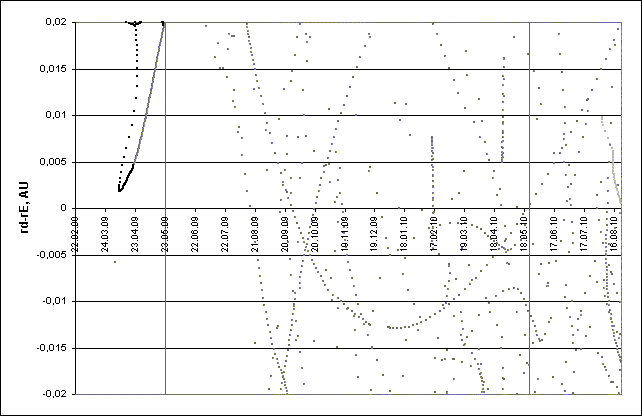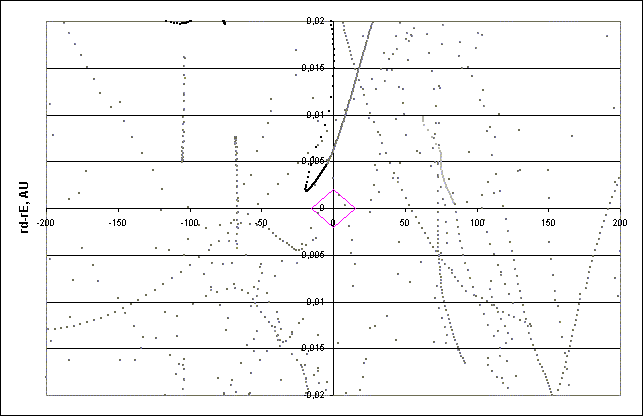73P-ids 2008: prediction of activity

Fig. 1. Space-temporal projection of 73P-ids trails parts onto their minimal distance to the Earth orbit passages.

Fig. 2. Difference between the solar longitudes of the minimal distance passge points and timings of the Earth passing the points of the same solar longitudes on its own orbit (axis X).
The red rhombus approximately restricts the area where the particles pass close enought to the Earth's orbit roughly in the same time with the Earth itself.
2009
No encounters with trail, activity is not expected.
2010
In 2010 a very thin trail (of 1941) is found within the rombus. It crosses the Earth's orbit 8.6 days after the Earth itself passes the point of intersection (solar longiture is 26.613°, corr. to 21:02 UT om 16 April 2010). However the characteristics of the trail - high ejection velocity and very low density (Vej=37.01 m/s, fM(fMD)=-0.049) doesn't allow to expect any activity.
References
1. "Comet's dust 2.0" program by S. Shanov and S. Dubrovsky. [Used for computation of stream particles orbital evolution]
2. Kazuo Kinosita, http://www9.ocn.ne.jp/~comet/index.html [Orbital elements of the comet 73P.]
3. Lyytinen E, van Flandern T. "Predicting the strength of Leonid outbursts", 2000, Icarus, P. 158-160.
2009
No encounters with trail, activity is not expected.
2010
In 2010 a very thin trail (of 1941) is found within the rombus. It crosses the Earth's orbit 8.6 days after the Earth itself passes the point of intersection (solar longiture is 26.613°, corr. to 21:02 UT om 16 April 2010). However the characteristics of the trail - high ejection velocity and very low density (Vej=37.01 m/s, fM(fMD)=-0.049) doesn't allow to expect any activity.
References
1. "Comet's dust 2.0" program by S. Shanov and S. Dubrovsky. [Used for computation of stream particles orbital evolution]
2. Kazuo Kinosita, http://www9.ocn.ne.jp/~comet/index.html [Orbital elements of the comet 73P.]
3. Lyytinen E, van Flandern T. "Predicting the strength of Leonid outbursts", 2000, Icarus, P. 158-160.